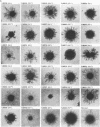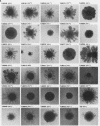Abstract
Saccharomyces cerevisiae isolates have been shown previously to exhibit a high degree of variation in their ability to proliferate and persist in CD-1 mice (K.V. Clemons, J.H. McCusker, R. W. Davis, and D.A. Stevens, J. Infect. Dis. 169:859-867, 1994). Isolate origin was not a firm predictor of virulence phenotype, since the virulence phenotypes of clinical and nonclinical isolates ranged from virulent to avirulent and from intermediate to avirulent, respectively. Therefore, it was important to determine if there was any association between putative virulence traits and virulence that might help explain the variation in virulence phenotypes. S. cerevisiae isolates spanning a range of virulence phenotypes in experimental infections were examined for putative virulence traits: the ability to grow at supraoptimal temperatures (42, 39, and 37 degrees C), gelatin liquefaction, casein utilization, and pseudohyphal formation. Gelatin liquefaction appeared to be unrelated to pseudohyphal formation on casein or to virulence. Significant differences in the ability to grow at 39 and 42 degrees C were observed when the virulent and intermediate classes were compared with the avirulent class. Less extreme but still significant differences in pseudohyphal formation were observed when the virulent and intermediate classes were compared with the avirulent class. Therefore, two virulence traits, similar to those identified in other pathogenic fungi, the ability to grow at elevated temperatures and pseudohyphal formation, have been identified in S. cerevisiae.
Full text
PDF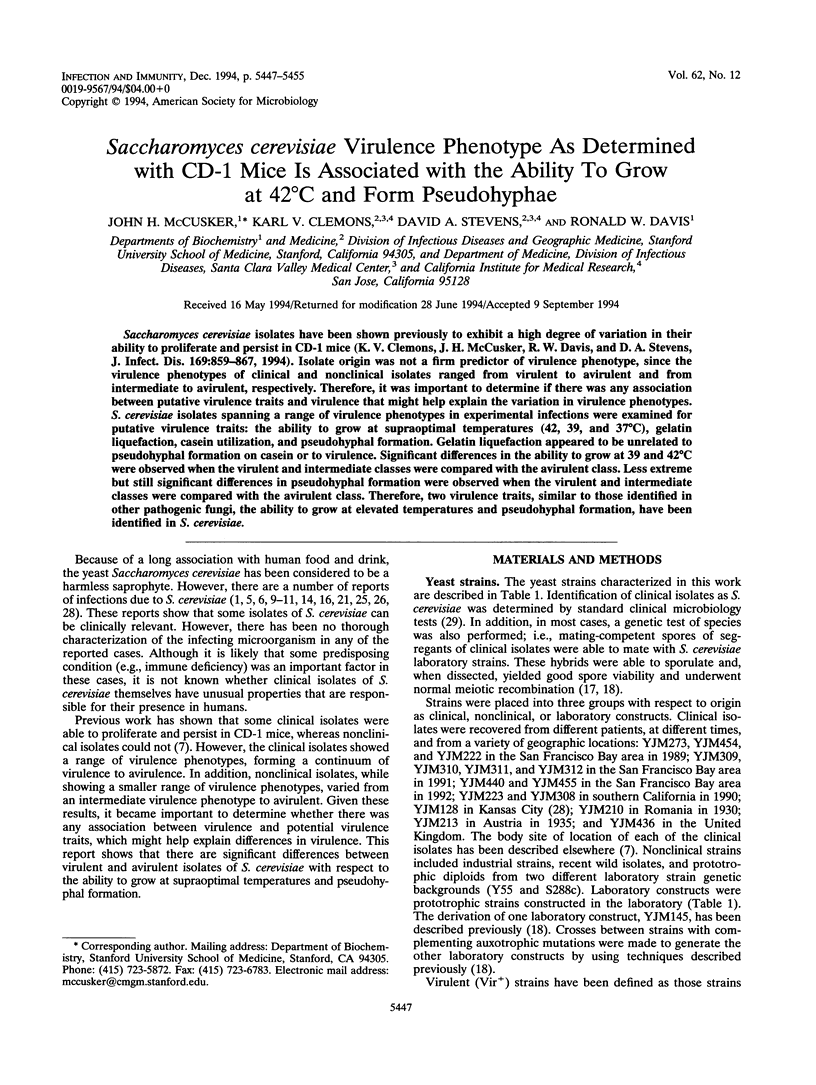
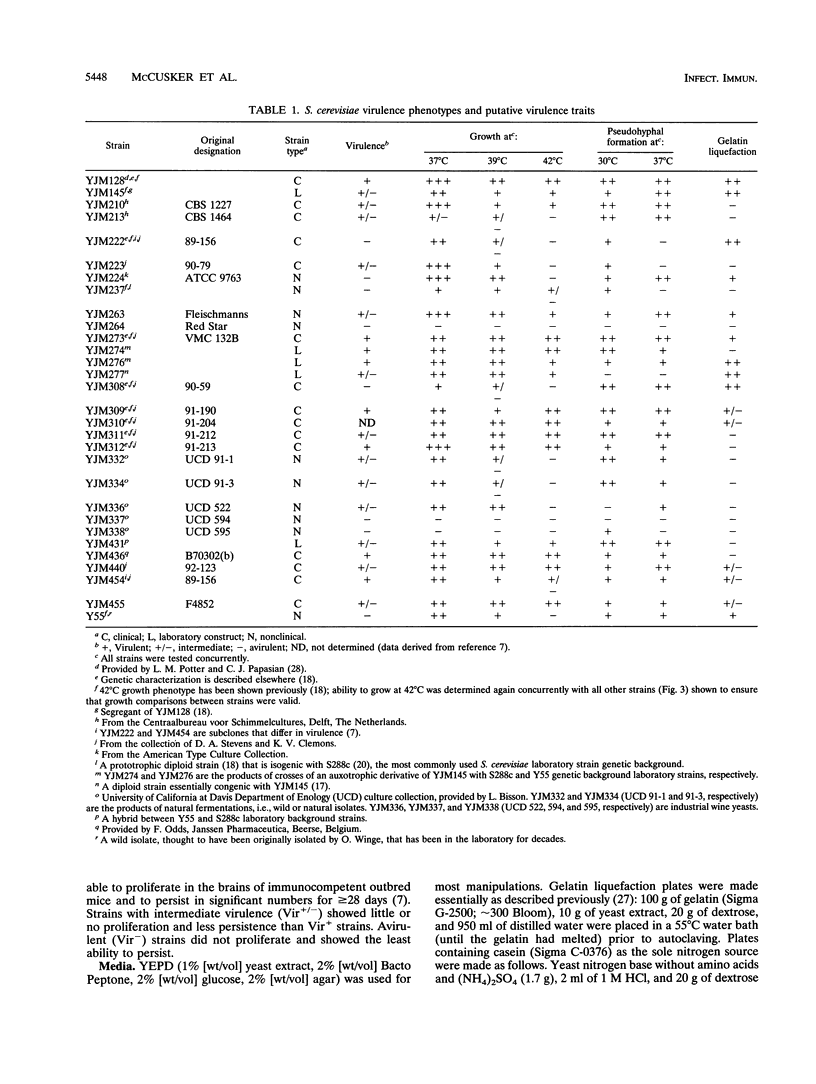
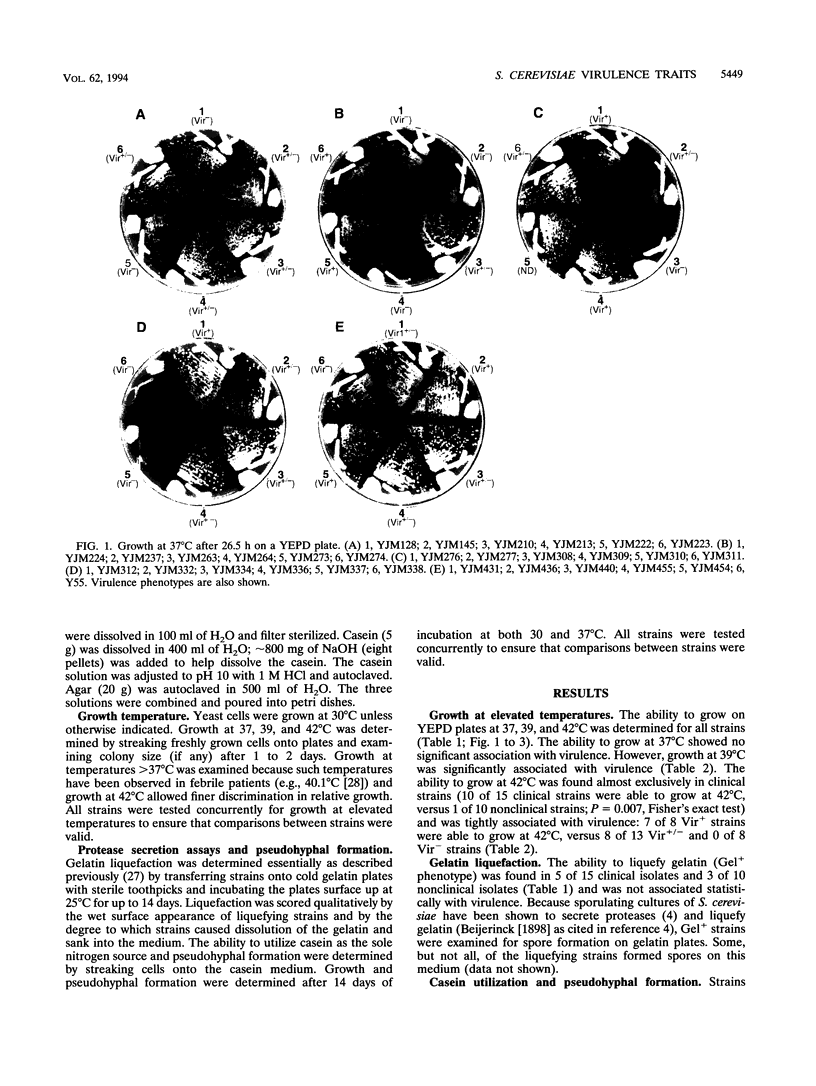
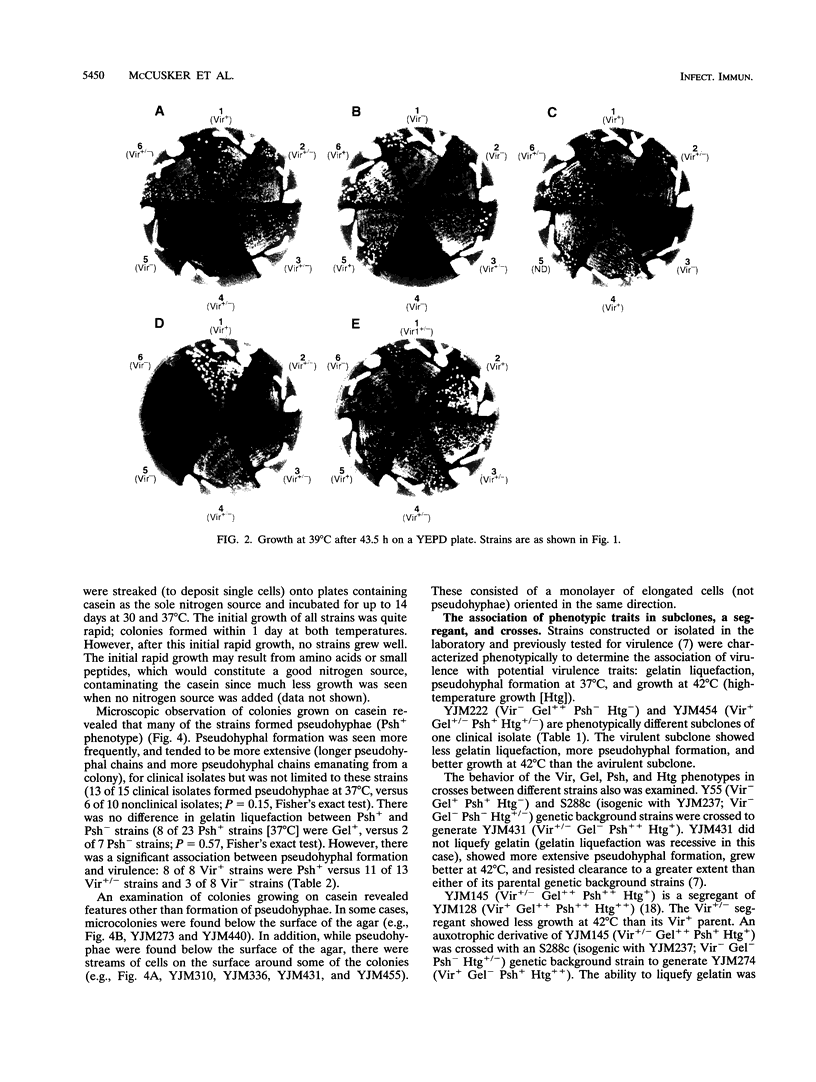
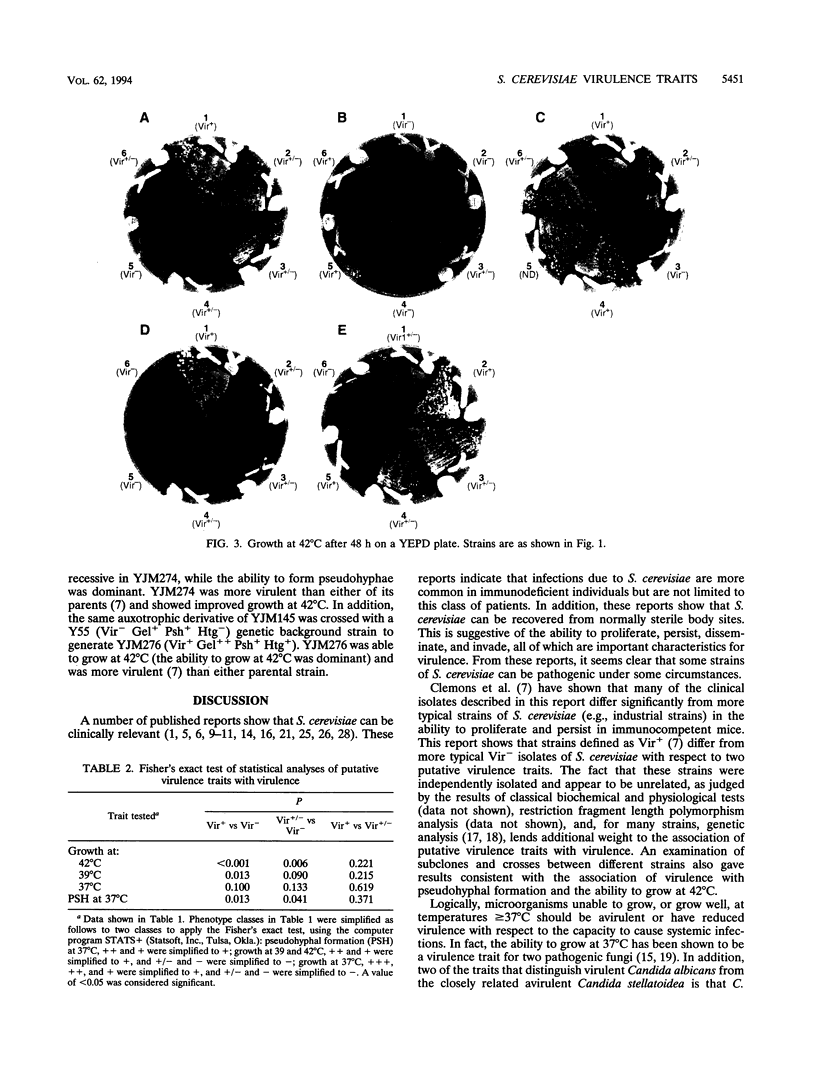
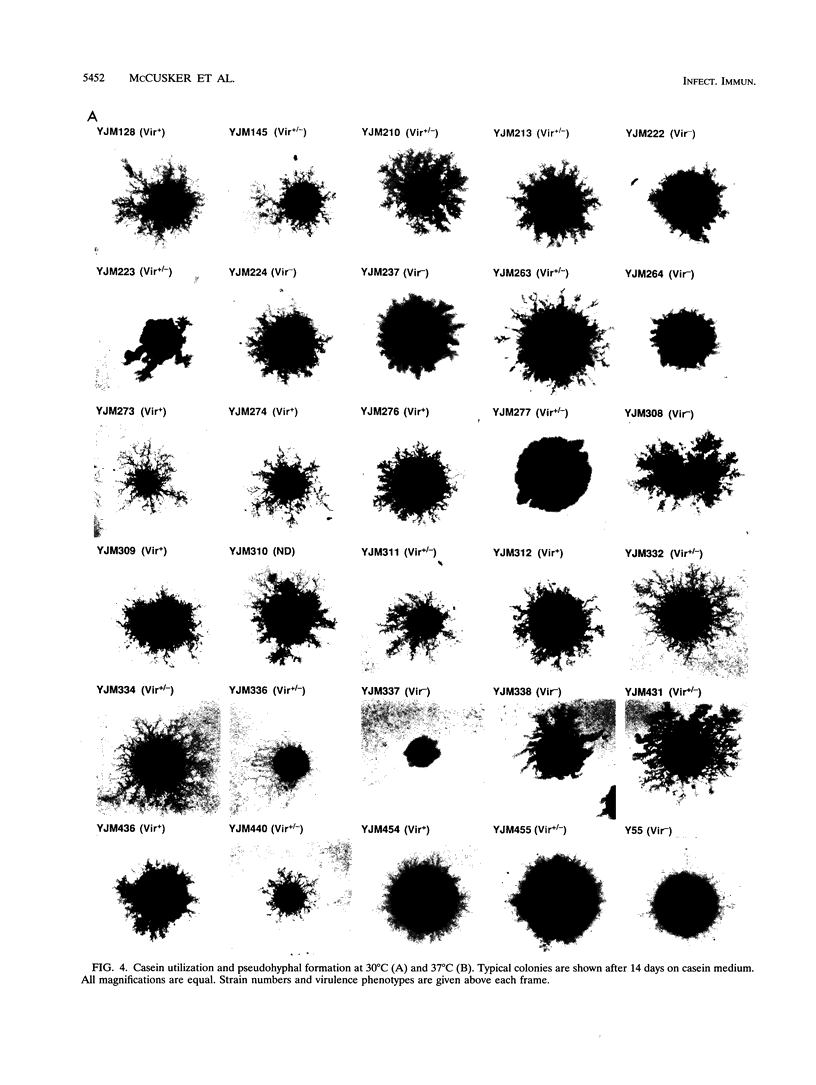
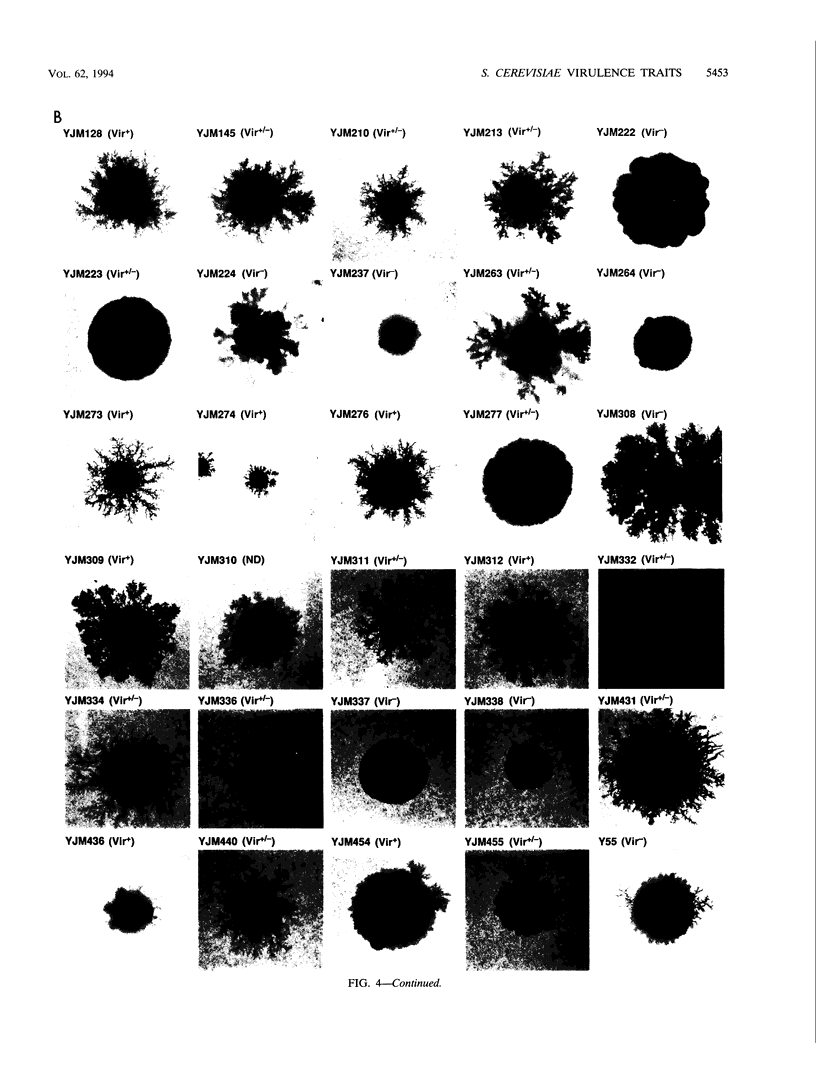
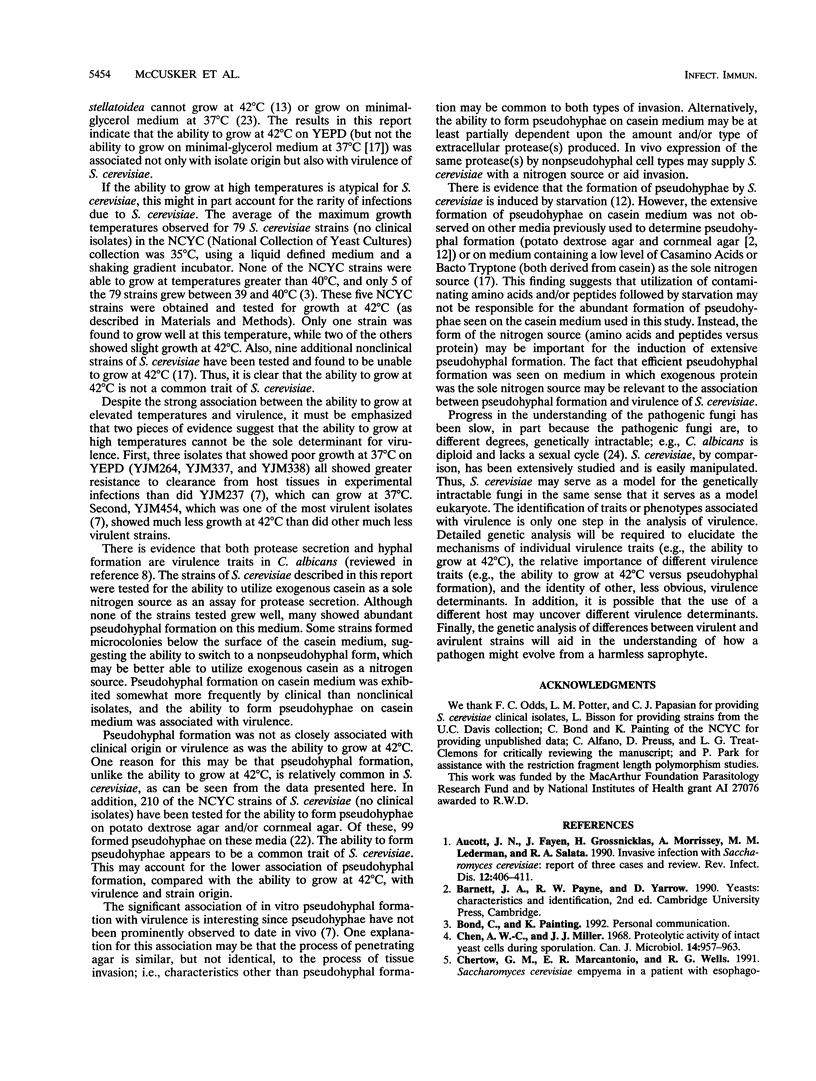
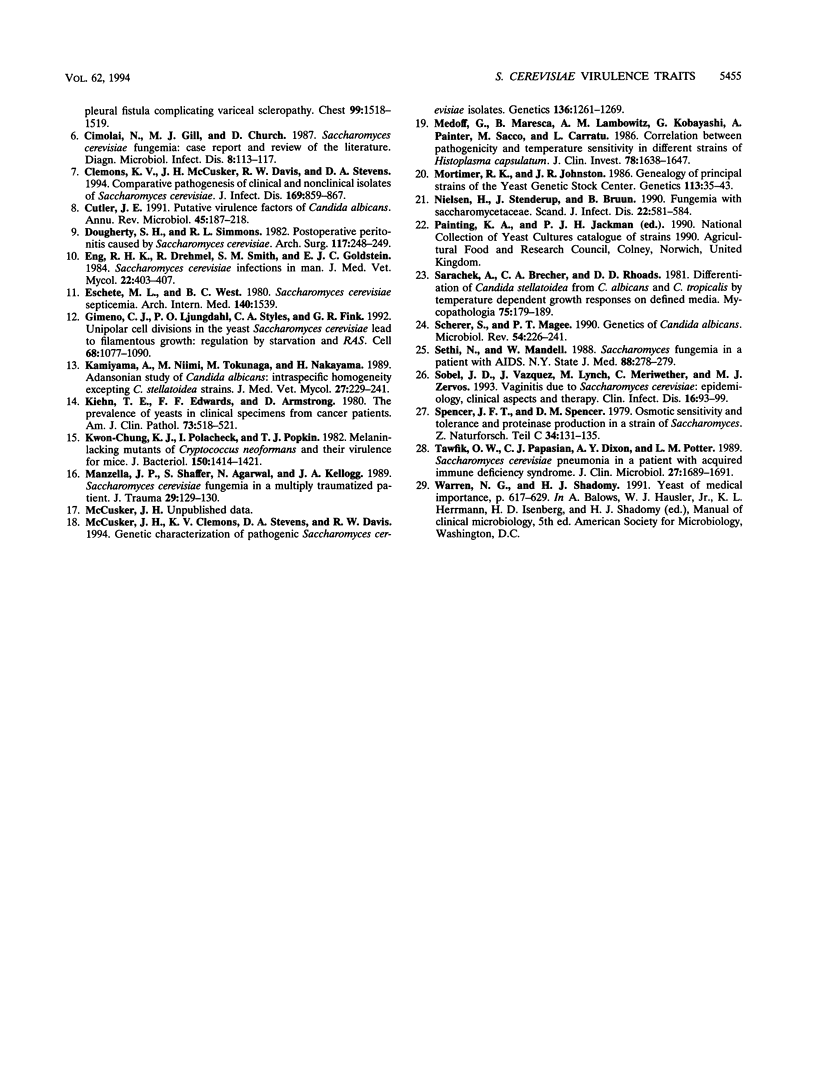
Images in this article
Selected References
These references are in PubMed. This may not be the complete list of references from this article.
- Aucott J. N., Fayen J., Grossnicklas H., Morrissey A., Lederman M. M., Salata R. A. Invasive infection with Saccharomyces cerevisiae: report of three cases and review. Rev Infect Dis. 1990 May-Jun;12(3):406–411. doi: 10.1093/clinids/12.3.406. [DOI] [PubMed] [Google Scholar]
- Chen A. W., Miller J. J. Proteolytic activity of intact yeast cells during sporulation. Can J Microbiol. 1968 Sep;14(9):957–963. doi: 10.1139/m68-159. [DOI] [PubMed] [Google Scholar]
- Chertow G. M., Marcantonio E. R., Wells R. G. Saccharomyces cerevisiae empyema in a patient with esophago-pleural fistula complicating variceal sclerotherapy. Chest. 1991 Jun;99(6):1518–1519. doi: 10.1378/chest.99.6.1518. [DOI] [PubMed] [Google Scholar]
- Cimolai N., Gill M. J., Church D. Saccharomyces cerevisiae fungemia: case report and review of the literature. Diagn Microbiol Infect Dis. 1987 Oct;8(2):113–117. doi: 10.1016/0732-8893(87)90158-1. [DOI] [PubMed] [Google Scholar]
- Clemons K. V., McCusker J. H., Davis R. W., Stevens D. A. Comparative pathogenesis of clinical and nonclinical isolates of Saccharomyces cerevisiae. J Infect Dis. 1994 Apr;169(4):859–867. doi: 10.1093/infdis/169.4.859. [DOI] [PubMed] [Google Scholar]
- Cutler J. E. Putative virulence factors of Candida albicans. Annu Rev Microbiol. 1991;45:187–218. doi: 10.1146/annurev.mi.45.100191.001155. [DOI] [PubMed] [Google Scholar]
- Dougherty S. H., Simmons R. L. Postoperative peritonitis caused by Saccharomyces cerevisiae. Arch Surg. 1982 Feb;117(2):248–248. doi: 10.1001/archsurg.1982.01380260114019. [DOI] [PubMed] [Google Scholar]
- Eng R. H., Drehmel R., Smith S. M., Goldstein E. J. Saccharomyces cerevisiae infections in man. Sabouraudia. 1984;22(5):403–407. [PubMed] [Google Scholar]
- Eschete M. L., West B. C. Saccharomyces cerevisiae septicemia. Arch Intern Med. 1980 Nov;140(11):1539–1539. [PubMed] [Google Scholar]
- Gimeno C. J., Ljungdahl P. O., Styles C. A., Fink G. R. Unipolar cell divisions in the yeast S. cerevisiae lead to filamentous growth: regulation by starvation and RAS. Cell. 1992 Mar 20;68(6):1077–1090. doi: 10.1016/0092-8674(92)90079-r. [DOI] [PubMed] [Google Scholar]
- Kamiyama A., Niimi M., Tokunaga M., Nakayama H. Adansonian study of Candida albicans: intraspecific homogeneity excepting C. stellatoidea strains. J Med Vet Mycol. 1989;27(4):229–241. [PubMed] [Google Scholar]
- Kiehn T. E., Edwards F. F., Armstrong D. The prevalence of yeasts in clinical specimens from cancer patients. Am J Clin Pathol. 1980 Apr;73(4):518–521. doi: 10.1093/ajcp/73.4.518. [DOI] [PubMed] [Google Scholar]
- Kwon-Chung K. J., Polacheck I., Popkin T. J. Melanin-lacking mutants of Cryptococcus neoformans and their virulence for mice. J Bacteriol. 1982 Jun;150(3):1414–1421. doi: 10.1128/jb.150.3.1414-1421.1982. [DOI] [PMC free article] [PubMed] [Google Scholar]
- Manzella J. P., Shaffer S., Agarwal N., Kellogg J. A. Saccharomyces cerevisiae fungemia in a multiply traumatized patient. J Trauma. 1989 Jan;29(1):129–130. doi: 10.1097/00005373-198901000-00032. [DOI] [PubMed] [Google Scholar]
- McCusker J. H., Clemons K. V., Stevens D. A., Davis R. W. Genetic characterization of pathogenic Saccharomyces cerevisiae isolates. Genetics. 1994 Apr;136(4):1261–1269. doi: 10.1093/genetics/136.4.1261. [DOI] [PMC free article] [PubMed] [Google Scholar]
- Medoff G., Maresca B., Lambowitz A. M., Kobayashi G., Painter A., Sacco M., Carratu L. Correlation between pathogenicity and temperature sensitivity in different strains of Histoplasma capsulatum. J Clin Invest. 1986 Dec;78(6):1638–1647. doi: 10.1172/JCI112757. [DOI] [PMC free article] [PubMed] [Google Scholar]
- Mortimer R. K., Johnston J. R. Genealogy of principal strains of the yeast genetic stock center. Genetics. 1986 May;113(1):35–43. doi: 10.1093/genetics/113.1.35. [DOI] [PMC free article] [PubMed] [Google Scholar]
- Nielsen H., Stenderup J., Bruun B. Fungemia with Saccharomycetaceae. Report of four cases and review of the literature. Scand J Infect Dis. 1990;22(5):581–584. doi: 10.3109/00365549009027100. [DOI] [PubMed] [Google Scholar]
- Sarachek A., Brecher C. A., Rhoads D. D. Differentiation of Candida stellatoidea from C. albicans and C. tropicalis by temperature-dependent growth responses on defined media. Mycopathologia. 1981 Sep 11;75(3):179–189. doi: 10.1007/BF00482814. [DOI] [PubMed] [Google Scholar]
- Scherer S., Magee P. T. Genetics of Candida albicans. Microbiol Rev. 1990 Sep;54(3):226–241. doi: 10.1128/mr.54.3.226-241.1990. [DOI] [PMC free article] [PubMed] [Google Scholar]
- Sethi N., Mandell W. Saccharomyces fungemia in a patient with AIDS. N Y State J Med. 1988 May;88(5):278–279. [PubMed] [Google Scholar]
- Sobel J. D., Vazquez J., Lynch M., Meriwether C., Zervos M. J. Vaginitis due to Saccharomyces cerevisiae: epidemiology, clinical aspects, and therapy. Clin Infect Dis. 1993 Jan;16(1):93–99. doi: 10.1093/clinids/16.1.93. [DOI] [PubMed] [Google Scholar]
- Spencer J. F., Spencer D. M. Osmotic sensitivity and tolerance and proteinase production in a strain of Saccharomyces. Z Naturforsch C. 1979 Jan-Feb;34(1-2):131–135. doi: 10.1515/znc-1979-1-226. [DOI] [PubMed] [Google Scholar]
- Tawfik O. W., Papasian C. J., Dixon A. Y., Potter L. M. Saccharomyces cerevisiae pneumonia in a patient with acquired immune deficiency syndrome. J Clin Microbiol. 1989 Jul;27(7):1689–1691. doi: 10.1128/jcm.27.7.1689-1691.1989. [DOI] [PMC free article] [PubMed] [Google Scholar]






